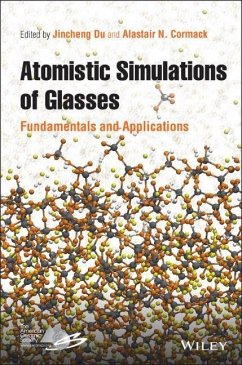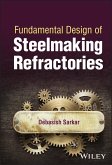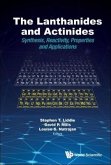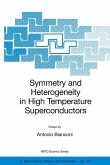Modeling and simulation are crucial for understanding structure-property relationships in glass-forming systems and for accelerating the design of next-generation glassy materials. Atomistic Simulations of Glasses is a comprehensive volume dedicated to the topic of atomic-scale modeling of glassy materials, with particular emphasis on silicate glasses of practical industrial interest. As such, this book fills a critical gap in the literature, offering an excellent introduction for newcomers to atomistic modeling, as well as a comprehensive and state-of-the-art reference for practitioners in the field.
Atomistic Simulations of Glasses, published by ACerS-Wiley, consists of 15 chapters written by experts from around the world. It is edited by two leading authorities in computational glass science: Jincheng Du (University of North Texas) and Alastair N. Cormack (Alfred University). The book itself is gorgeous, printed in full color on high-quality paper. It is designed in a reader-friendly format, including a comprehensive index, an extensive list of references at the end of each chapter, and a helpful table to decode every acronym used throughout the book. Each chapter is well written and has been carefully polished. The text also flows smoothly across chapters, which is sometimes a problem in edited volumes.
The first five chapters are devoted to fundamentals of atomistic modeling techniques for glassy systems, including classical simulation methods (Chapter 1), quantum mechanical techniques (Chapter 2), reverse Monte Carlo (Chapter 3), structural analysis methods (Chapter 4), and topological constraint theory (Chapter 5). Each of these chapters does a great job at providing both foundational knowledge and discussing the state-of-the-art in methods and tools. The chapter on topological constraint theory is especially interesting because this is a family of techniques developed specifically for glassy materials.
The latter 10 chapters of the book focus on application of these techniques for simulating various glass families of interest. These chapters cover a wide range of silicate, aluminosilicate, and borosilicate glasses, as well as phosphate, fluoride, and oxyfluoride systems. The coverage of transition metal and rare-earth-containing glasses is also a nice touch. There is a particular emphasis on bioactive glasses and glasses for nuclear waste immobilization. As a whole, the 10 application-focused chapters do an excellent job demonstrating the utility and versatility of atomistic simulation approaches for addressing problems of practical concern in the glass science and engineering community. These chapters also provide good perspective on specific needs for future developments in the field.
There are a few missing topics that would have been valuable to include in the book. While reactive force fields are mentioned briefly, an entire chapter devoted to the principles and applications of reactive force fields such as ReaxFF would have been a nice addition, especially because reactive force fields are becoming increasingly important in the glass science community. Also, given the importance of thermal history in governing the structure and properties of glasses, it would have been worthwhile to include a chapter on accessing long time scales, e.g., using kinetic Monte Carlo, meta-dynamics, or the activation-relaxation technique, all of which have been applied to noncrystalline systems in the literature and can enable simulations to access experimental time scales. It also would have been helpful to expand the chapter on reverse Monte Carlo to include other Monte Carlo techniques more broadly; for example, Metropolis Monte Carlo is a computationally efficient alternative to molecular dynamics for calculating glass structure and static properties. Finally, given the large amount of research activity in modeling of metallic glasses, a chapter on atomistic simulations of metallic glasses would be a nice addition.
Overall, Atomistic Simulations of Glasses is a very welcome addition to the literature and highly recommended for both students and professionals in the field of computational glass science.
--John C. Mauro is a Dorothy Pate Enright Professor in the Department of Materials Science and Engineering at The Pennsylvania State University
Atomistic Simulations of Glasses, published by ACerS-Wiley, consists of 15 chapters written by experts from around the world. It is edited by two leading authorities in computational glass science: Jincheng Du (University of North Texas) and Alastair N. Cormack (Alfred University). The book itself is gorgeous, printed in full color on high-quality paper. It is designed in a reader-friendly format, including a comprehensive index, an extensive list of references at the end of each chapter, and a helpful table to decode every acronym used throughout the book. Each chapter is well written and has been carefully polished. The text also flows smoothly across chapters, which is sometimes a problem in edited volumes.
The first five chapters are devoted to fundamentals of atomistic modeling techniques for glassy systems, including classical simulation methods (Chapter 1), quantum mechanical techniques (Chapter 2), reverse Monte Carlo (Chapter 3), structural analysis methods (Chapter 4), and topological constraint theory (Chapter 5). Each of these chapters does a great job at providing both foundational knowledge and discussing the state-of-the-art in methods and tools. The chapter on topological constraint theory is especially interesting because this is a family of techniques developed specifically for glassy materials.
The latter 10 chapters of the book focus on application of these techniques for simulating various glass families of interest. These chapters cover a wide range of silicate, aluminosilicate, and borosilicate glasses, as well as phosphate, fluoride, and oxyfluoride systems. The coverage of transition metal and rare-earth-containing glasses is also a nice touch. There is a particular emphasis on bioactive glasses and glasses for nuclear waste immobilization. As a whole, the 10 application-focused chapters do an excellent job demonstrating the utility and versatility of atomistic simulation approaches for addressing problems of practical concern in the glass science and engineering community. These chapters also provide good perspective on specific needs for future developments in the field.
There are a few missing topics that would have been valuable to include in the book. While reactive force fields are mentioned briefly, an entire chapter devoted to the principles and applications of reactive force fields such as ReaxFF would have been a nice addition, especially because reactive force fields are becoming increasingly important in the glass science community. Also, given the importance of thermal history in governing the structure and properties of glasses, it would have been worthwhile to include a chapter on accessing long time scales, e.g., using kinetic Monte Carlo, meta-dynamics, or the activation-relaxation technique, all of which have been applied to noncrystalline systems in the literature and can enable simulations to access experimental time scales. It also would have been helpful to expand the chapter on reverse Monte Carlo to include other Monte Carlo techniques more broadly; for example, Metropolis Monte Carlo is a computationally efficient alternative to molecular dynamics for calculating glass structure and static properties. Finally, given the large amount of research activity in modeling of metallic glasses, a chapter on atomistic simulations of metallic glasses would be a nice addition.
Overall, Atomistic Simulations of Glasses is a very welcome addition to the literature and highly recommended for both students and professionals in the field of computational glass science.
--John C. Mauro is a Dorothy Pate Enright Professor in the Department of Materials Science and Engineering at The Pennsylvania State University








